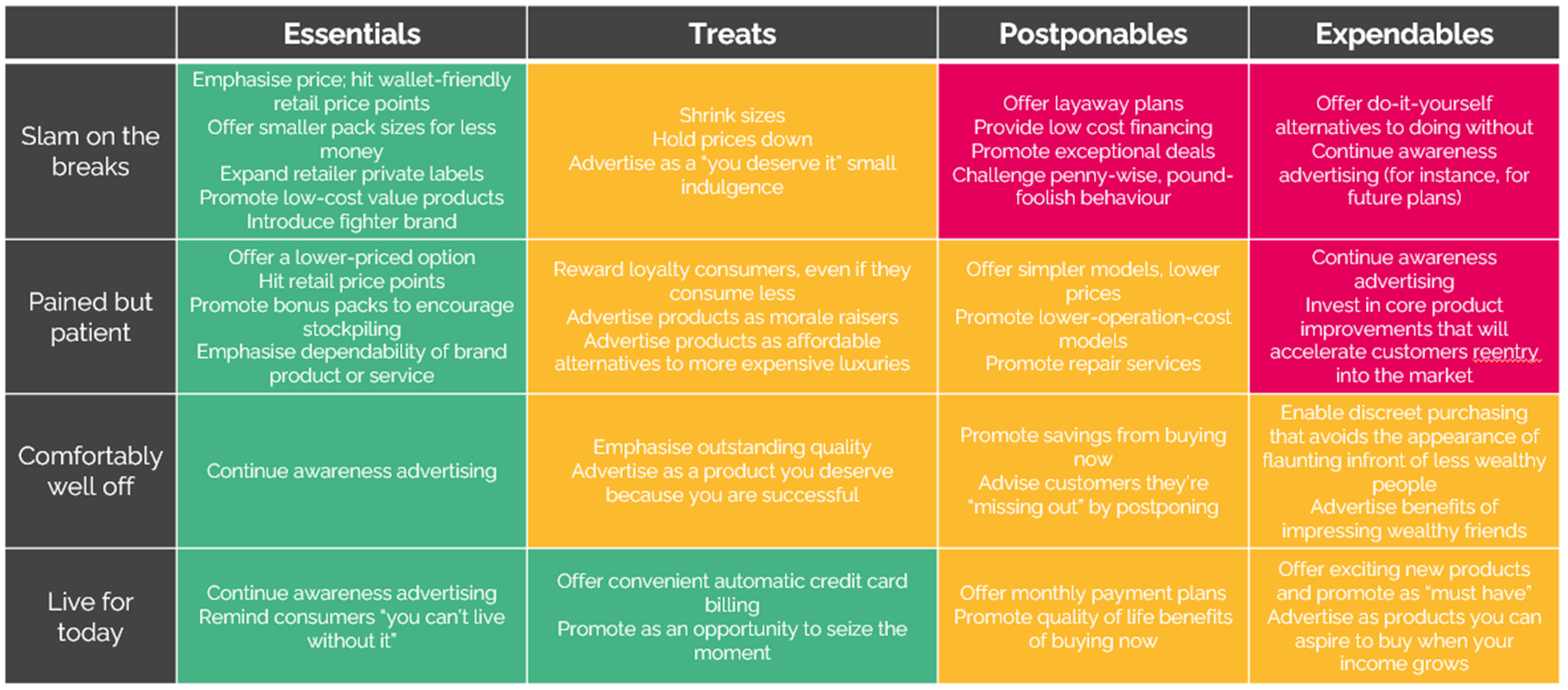August Round-up: Better Meta Targeting, Google Glitch & UX Best Practice
The latest version of our newsletter should have settled in your email inbox, detailing the need-to-know information and must-read thought leadership...
Read moreWe recently talked about types of consumer spending and how this trends and changes during a recession, so how do we tailor conversion tactics to encourage consumer action?
A big part of recession spending is understanding more about your consumers and how their behaviour is likely to change during a recession, but we can help you take this one step further.
While spending changes during a recession, it means that budget is usually pulled from digital marketing teams, so there is a lot of pressure to do more with less and show high returns on the investment into marketing.
It is important to continue to keep this balanced as strong brands can typically be carried based on their previous efforts, however, no brand can afford to rely solely on their earlier efforts.
Out of sight, out of mind is particularly true within digital and as soon as the brand is not front and centre, conversions and spending are likely to decrease, so this is where it is encouraged to keep budgets at similar levels while tailoring conversion tactics to fit with consumer spending.
In our last article, ‘what happens to consumer spending during a recession’, we covered the four categories that consumers tend to fall into:
We also layered this against consumption and how products are categorised by consumers during a recession:
Leveraging these audiences comes down to tailoring the digital marketing tactics we’re using. We discussed last time about the green, yellow and red areas and we can still impact all of these, using a framework for messaging:

For these consumers, most of the spending will stop or slow down, as they look to economise across all areas of their spending. Across each of the levels of consumption, messaging can be approached differently to tackle this:
Essentials
Products and services need to be focused on the price, which where possible, is as wallet friendly as possible to encourage more purchases. This can often be through doing things such as making smaller sizes with a lower quantity or features for a lower price point. Where a retailer has their own product or service, it might mean expanding these ‘labels’ or ‘brands’ to keep cost lower. Marketing needs to be focused on promoting lower-cost products with a ‘fighter brand’ being introduced, which is a lower-priced solution specifically priced for the market.
Treats
Again here, the focus needs to be on shrinking sizes and keeping prices low (where possible!) without having a negative impact on bottom line. The messaging can be around that treat element, with wording like ‘you deserve it’ which supports the treat aspect of the product or service.
Postponables
As these are likely going to be purchased later, the focus can be on low-cost financing, promoting any exceptional deals which are likely to sway the decision of consumers. Challenge the idea that the product or service is a postponable, especially if it is something that is a risk if not purchased, tying in the risk-averse nature of consumers.
Expendables
Where spending is really going to slow down, try and encourage any DIY alternatives to doing without to maintain presence for the consumer, continuing to maximise on the awareness piece for when consumer behaviour switches.
As this category makes up the biggest percentage of consumers, this is where most advertisers’ focus will go and rightfully so – this makes up the biggest chunk, meaning it would be the biggest impact area to spend time:
Essentials
Here the focus should be on lower-priced options ensuring that these are competitive and in-line with other price points. As these people are patient, they may be convinced to bulk buy while prices are good, so bonus packs can work well. The other element here is around prioritising the brand dependability, supporting the loyalty and advocacy for consumers.
Treats
As these people will continue spending in this category, it is ensuring you start or continue to reward loyal consumers, even if they are spending or shopping less, while advertising products as items to improve morale and happiness. As the treats category tends to play into the ego principle, where we like to buy things to make us feel better about ourselves, focusing the messaging on a cheaper treat for a luxury alternative can work well to encourage a purchase.
Postponables
The focus here should be on simpler models with lower prices or, where relevant, promoting repair or aftercare services as although the initial purchase may be postponed, where the consumer already has a product or service, they would be more likely to upsell or cross-sell.
Expendables
Similar to slam on the breaks, there should be a focus on continuing any awareness activity and investing in any core product or service improvements which makes it easier for consumers to come back into the market and purchase, when they are ready.
This is an area where although spending will not slow down at the same level, there are still messaging amends you can make to encourage a purchase:
Essentials
Opposite to some of the other personas we’ve talked about, the focus should be on continuing awareness advertising. As it’s an essential product and this consumer segment is comfortably well-off, it’s just reminding them that the product or service still exists and can still be purchased from.
Treats
The focus here should be on quality, ensuring consumers are aware of the quality compared to other products and services. The messaging needs to play on the top percentage of the income, recommending a purchase as something that is deserved because the individual is successful and can afford to treat themselves.
Postponables
Some of this spending may slow down, so the key messaging here can be around promoting savings from purchasing now, rather than postponing and playing on the FOMO (fear of missing out) aspect of marketing, confirming that people will be missing out if they aren’t purchasing now.
Expendables
The interesting interaction that happens at this level is that although this consumer segment is able to keep spending, they are more conscious of doing this when others may be in financial difficulty. This means it is important to enable discrete purchases, while advertising benefits of the impact this purchase will have on their wealthy friends, ensuring they can demonstrate social proof within their group of peers where spending continues.
This is again, an area where spending will not slow down at the same level, so focusing on things that are important to those quick, impulsive consumers will encourage spending to continue:
Essentials
Awareness advertising needs to continue here, ensuring the brand is front of mind. The messaging can be focused on reminding consumers that they need it, as an essential product or service, playing on this with content around not being able to live without it.
Treats
These products or services can often fall into things like subscription services, so by allowing easy automatic billing on a semi-regular schedule can keep revenue coming in for this segment. The messaging should be focused on seizing the moment as this is something that resonates well with treat purchasers.
Postponables
Monthly payment plans and credit lines can work well here, while promoting the benefits of purchasing now rather than postponing, using any specific quality of life benefits for this consumer segment.
Expendables
Focus on offering new products and exciting new collections while categorising these as ‘must-have’ products. You can also market them as products consumers can aspire to, so as and when income grows, this can be a goal or target for them to achieve and purchase.
By learning more about the target consumer you are trying to reach, continuing to run activity across all stages of the funnel and using messaging which ties into the motivating factors for these consumers, it can help to keep revenue coming in, with brands able to support consumers, no matter where they sit within the funnel:
If you’d like to chat to our experts about the messaging you can use during a recession to capture attention, contact us now.
Photo by Blake Wisz on Unsplash
More articles you might be interested in:

The latest version of our newsletter should have settled in your email inbox, detailing the need-to-know information and must-read thought leadership...
Read more
As the cost of living continues to present challenges for many Brits, an increasing number of families are choosing to holiday within the United...
Read more
Our first curated newsletter has hit inboxes, detailing all of the latest need-to-know information and sharing all the necessary thought leadership...
Read more
Over the past few years, marketing leaders have been gearing up for the inevitable 'Cookieless Future'. Safari was the first to bid farewell to...
Read more
It only seems like yesterday that it was the winter of 2022 and we were balancing Black Friday and the Qatar World Cup. Fast forward to now and we're...
Read more
There are many factors to consider when choosing an automotive dealership, with 53% of customers saying that price determines which dealership they...
Read more
Which UK-based private healthcare providers are running away with their digital presence and who needs a helping hand to take the next step? How is...
Read more
How prepared are you for planning & budgeting season? Dave Chaffey shares some of the questions you should ask yourself when planning marketing...
Read more